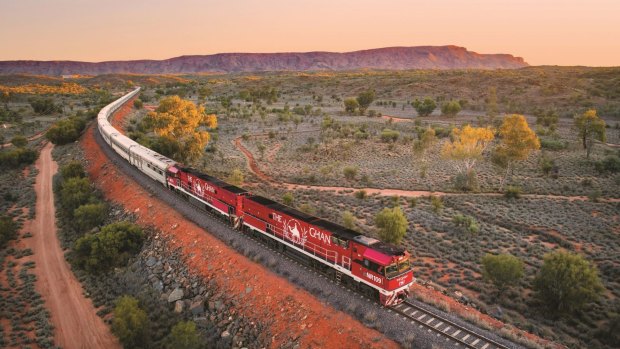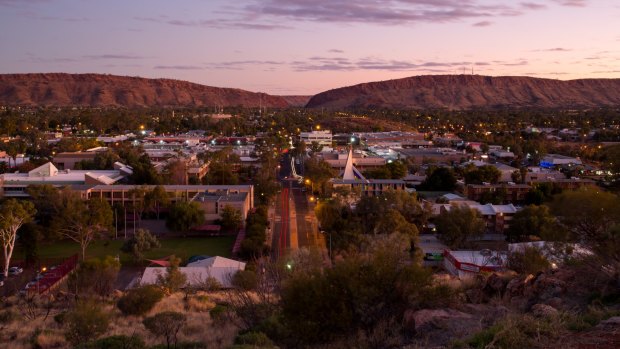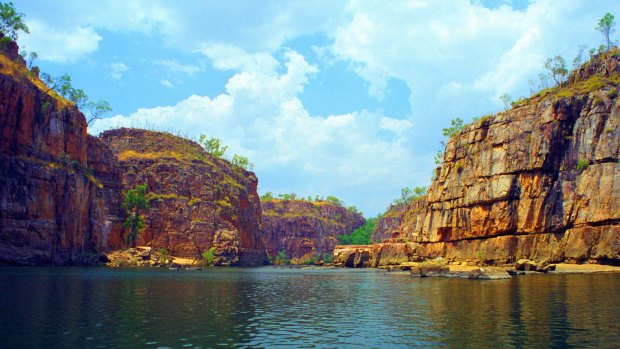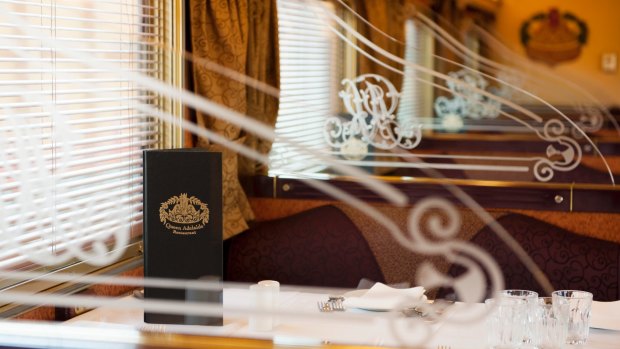This was published 4 years ago
Travelling on the Ghan: Eight things that make it one of the world's great train journeys
By Anthony Dennis

One of the greats: The Ghan.
Inside the dining car of the Ghan, with South Australia's Flinders Ranges unfurling beyond the double-glazing like an unceasing carpet salesman's pitch, I pop myself down at a table and try to drown out the clickety-clack of the train on the track - music to the ears of any rail fancier - in order to hear another sound.
I'm listening out for a fainter, more subtle noise, one that truly denotes a great railway journey: the tinkling of silver cutlery - rocked ever-so-gently by the constant rhythms of the train - on a table draped in white cloth.
Dining cars - authentic dining cars where the food, or most of it, is still cooked onboard, in a kitchen not much bigger than a bedroom wardrobe - are becoming as rare nowadays as rain clouds in the outback.

View from Anzac Hill down Hartley St in Alice Springs, Northern Territory.
Yet without a dining car you can't really rank as one of the world's greatest railway journeys, taking your place alongside the Trans-Siberian and the Venice-Simplon Orient Express. Dining aboard a train is among the last of travel's most civilised experiences, in a world where travel is rapidly becoming increasingly less civil.
The Ghan, which traces a long, thin vein across the map of central Australia between Adelaide and Darwin over a distance of 2979 kilometres, most certainly qualifies as one of the world's great rail journeys, and an unapologetically Australian one at that (it once even boasted a pokies carriage).
This year the train celebrated its 90th anniversary, the Ghan's dotage coinciding with rail travel re-emerging the world over as one of the most environmentally forgiving forms of transport in this fretful age of climate-change inspired "flight-shaming".

Katherine Gorge, which sits in the Nitmiluk National Park, has great ceremonial significance to the local Jawoyn people.
A journey on the Ghan between Adelaide and Darwin earlier this year - on the service commemorating the service's nine, at times decidedly shaky decades on its ribbons of steel - offered me not just an opportunity to reacquaint myself with a train I've travelled aboard before, but also to take rolling stock of the essential characteristics that define a great long-distance train.
THE IDENTITY
A great train journey of the world deserves a name that conjures either its heritage or the epic nature of its journey, or both. Take India's Maharaja Express, America's the Empire Builder, south-east Asia's the Eastern & Oriental Express, Britain's Royal Scotsman and, of course, Russia's Trans-Siberian.

The dining car on The Ghan.
The majority of these great train journeys share an identity as sturdy as the ballast beneath their tracks, one that's as much an integral part of the experience as the rolling stock as itself.
The Ghan forged its own distinct personality, in what was an early manifestation of multiculturalism's benefits, in the 19th and early 20th century when Afghan cameleers opened up the outback with their unsinkable ships of the desert, and after whom the train famously borrows its name.
Ensconced inside the stainless-steel cocoon of the train, gliding across the featureless red desert, as flat as the latest Reserve Bank economic outlook, while reaching for another glass of South Australia's finest, it's easy to underestimate the harshness of the environment through which it passes.
Until fairly recently, the Ghan was an essential transport service. But with the demise of the budget-oriented "sit-ups" carriages, it has become a fully-fledged rail cruise, with less emphasis on the timetable and more on the journey itself. This spirit of a cruise can be felt in the variety of off-train excursions, including dinners under the stars beside the train.
The Ghan's greatness is now founded not just on its vintage but on the fact that it's a miracle on wheels (many, many, many wheels: at peak times the train is almost a kilometre long) because it's still operating.
There have been several occasions in its history - most of which occurred when it was government-owned - when it was threatened by closure, but somehow it has managed to survive and even prosper, passing yet another test for a great rail journey of the world: durability.
THE DEPARTURE
To qualify as one of the world's great trains, a long-distance train should ideally begin and, better still, conclude its journey from a grand, preferably historic, railway station. Based on this criterion, the Ghan fails because - with the 19th-century Adelaide Railway Station having been repurposed in 1984 as a casino - it arrives and departs from a prosaic contemporary station in the scruffy suburbia beyond Adelaide's green belt.
It's hardly New York's Grand Central though even that terminus has been victim to similar economic rationalism - all the great trains of the US Amtrak fleet now depart from grimy and dingy Penn Station deep below Madison Square Garden.
Fortunately, the Indian Pacific - the Ghan's sister train, which spans the nation's east and west seaboards, and which has also faced extinction - departs from Sydney's sandstone, heritage-listed 19th-century Central Station, with its vast vaulted ceiling, expansive concourse and soaring clocktower.
THE JOURNEY
Not all of the world's great train journeys cover an epic distance but to qualify for the list, an extended period on the tracks certainly helps. To that end, the Ghan, and its sister train, the Indian Pacific, which operates along the 4352-kilometre Sydney and Perth corridor, more than adequately qualify.
But what makes both trains truly great in this context is the fact that they are among the only trains in the world to span a continent, with the Ghan travelling north-south-north and the Indian Pacific east-west-east, uniting Australia's far-flung and distinct seaboards. To achieve this feat in both the US and Canada, it's necessary to take at least two trains.
THE SCENERY
No matter how luxurious its onboard train facilities may be, to qualify for great train status, you must pass through magnificent if not cinematic landscapes.
Between Adelaide and Darwin, and vice versa, there's no shortage of starkly awe-inspiring landscapes to absorb in the abundant hours spent on the tracks. But the real appeal of the Ghan lies in the dramatic, almost magical transition that occurs, literally overnight, when you pass from the harsh, unforgiving red centre which dominates a large section of the journey, to the lush green of the tropical far north.
The grandeur of the landscapes is underscored by the Ghan's off-train excursion from Katherine, the outback town of 24,000 just under 320 kilometres south of Darwin, to nearby Nitmiluk National Park. The park - the crowning glory of which is the Nitmiluk Gorge, formerly known as Katherine Gorge - consists of more than a dozen sandstone gorges with seemingly enough water within them to quench a drought in the south.
THE LOUNGE CAR
A great train is a moving, albeit temporary, community and that community demands an appropriate meeting place: the lounge car. Without this venue, the passengers would be prisoners of their compartments, impatiently awaiting the next sitting in the dining car.
Now that many passenger jets are Wi-Fi-enabled, as are cruise ships, the lounge car on trains such as the Ghan remains one of the last device-free vestiges of travel.
But there's one welcome piece of technology that's crept into this part of the train.
It's the espresso machine that has found a permanent place in the bar of the lounge car. It's the place where alcohol flows freely as well as that most endangered of commodities: face-to-face conversation.
Strangers are brought together and fleeting and even permanent friendships are forged as the train trundles resolutely onwards. But these days on the Ghan and the Indian Pacific, although different tiers of travel have always existed, some of the intrinsic egalitarian nature of the trains has been lost, with passengers effectively split between the rail equivalent of business class and premium economy.
THE SLEEPERS
The smallest of the Ghan's retro sleeping compartments, ingeniously designed to ration space and transforming from bed to seat in an instant, predate the latest boutique hotel fad for micro-sized rooms.
Aboard the Ghan your compartment includes a shower (you need to remember to drag the curtain around the toilet and basin), with water pressure that's better than that found in some country motels, and something that until recently even the mythologised Venice-Simplon Orient Express could not offer. It really must be murder on the Orient Express to arrive at your destination freshly scented but unshowered.
Of course, there are no televisions in the Ghan's compartments but, for the next best alternative - superior to any breakfast show full of bleary-eyed hosts feigning hilarity - leave your window blinds slightly open allowing, in your supine state, the first rays of the morning sun to flood your moving room with orange-tinted light.
Then make yourself decent in readiness for one of the more quaint features to survive the move to privatisation, the morning tea or coffee and a biscuit delivered to your compartment. That said, you'll need to scamper to the lounge car if you want a proper espresso-style cuppa.
THE FOOD
Here we are where we began, back in the dining car, my favourite place on the train, as you may have guessed by now, choosing from a contemporary Australian menu with subtle bush-tucker touches, and with dishes that would be right at home at a top (stationary) city restaurant.
If an army marches on its stomach, the morale of the ever-peckish passengers on a great long-distance train depends on its dining cars.
When Amtrak in the US decided to stop cooking food on its train and instead brought aboard meals prepared elsewhere, the uproar from train fanciers made it on to the front page of august newspapers such as the Wall Street Journal.
But while the food aboard the Ghan is world-class it hasn't always flowed as smoothly from the galley. Once, when the Ghan was stranded in the flood waters that used to plague it routinely, the conductors were forced to shoot a shipment of goats to feed the hungry passengers, or so the story goes. It doesn't get more fresh and locally-sourced than that.
THE ARRIVAL
After leaving Adelaide, close to 3000 kilometres must be travelled before you reach another major city (sorry, Alice Springs), and Darwin itself, with a population of less than 150,000, still ranks as only the 15th or so largest urban centre in Australia.
The hopelessly unromantic bureaucrats who extended the ostensibly freight-focused line beyond Alice Springs to Darwin in 2004 decided to locate yet another terminal, like the one back in Adelaide, at a distance from the city. One of the world's great train journeys deserves better.
But, as you disembark the Ghan, stepping down onto terra firma from your finally-at-rest silver capsule for the last time and heading into the real centre of town by road, there's the realisation that you came, you saw, you ate, you drank (too much, probably), you conversed and you didn't check your mobile phone for reception (much). Yet above all, you've achieved the basic human satisfaction that emerges at the successful completion of any epic journey: you've made it.
TIMES LINES: FIVE GREAT MOMENTS IN THE LIFE OF A GREAT TRAIN
1929
The first, unnamed train, with 100 passengers aboard as well as Her Majesty's mail and fresh produce, departs Adelaide and Alice Springs. At some point along the way the train is christened "The Afghan Express", later to be abbreviated, in true Australian style, to the "Ghan".
1954
After playing an important role in World War II transporting troops to Alice Springs, from where they were transferred by road to Darwin, the Ghan's steam locomotives are replaced by more powerful diesel engines, rendering the train not only considerably faster but also cheaper to operate.
1980
Due to its unreliability in times of flood as well as the vulnerability of its timber sleepers to termites, the Ghan's old route via Marree and Oodnadatta is abandoned. In 1980, a new standard-gauge, less flood-prone line opens with concrete sleepers and the Ghan sheds its reputation for being incident-prone.
2004
The nation-building ambition to connect the continent by rail not just from east to west but also from north to southis finally realised when the 1420 kilometre, $1.3 billion track is completed, uniting Adelaide and Darwin. The inaugural journey of the Ghan - which is more than one kilometre long, with two locomotives and 43 carriages - marks the longest passenger train in Australia's history.
2019
The operators of the Ghan mark its 90th anniversary - its sister train, the Indian Pacific, will turn 50 next year - with a special commemorative journey between Adelaide and Darwin. The occasion includes an outback concert under the stars, set beside a stationary Ghan and starring three of Australia's leading rock performers: Christine Anu, Joe Camilleri and Shane Howard.
THE GHAN IN NUMBERS
2979
The number of kilometres the Ghan travels between Adelaide and Darwin.
54
The number of hours typically taken for the the journey between Adelaide and Darwin.
85
The average speed of the Ghan, in kilometres per hour.
115
The maximum speed of the Ghan, in kilometres per hour.
744
The average length of the Ghan, including its locomotives and carriages.
FIVE MORE GREAT TRAIN JOURNEYS OF THE WORLD
THE INDIAN PACIFIC, AUSTRALIA
Along with its stablemate The Ghan, the Indian Pacific is a train that spans a continent. It links the nation's eastern and western seaboards, between Sydney and Perth, with a large proportion of its journey spent traversing the Nullarbor Plain. It lacks much of the rollicking history of the Ghan but its journey is by sheer distance alone is even more epic. See journeybeyond.com
EASTERN & ORIENTAL EXPRESS, SOUTH-EAST ASIA
The luxurious Eastern & Oriental Express between Singapore and Bangkok is operated by the same company as the even more opulent Venice-Simplon Orient Express. The E&O's onboard facilities and the service provided by the abundant and charming staff are impeccable, with the train passing through dense jungles as it links two of south-east Asia's greatest population centres. See belmond.com
THE BLUE TRAIN, SOUTH AFRICA
South Africa's legendary Blue Train, operating the 1455 kilometres between Pretoria and Cape Town, is also one of the world's most luxurious, with one of its compartments coming complete with a claw-foot bath. Such comfort can be a contrast to the poverty outside the windows of the carriages. There are also plenty of African wildlife-spotting opportunities. See bluetrain.co.za
ROCKY MOUNTAINEER, CANADA
A long-time favourite of Australian travellers, this signature Canadian tourist train is well-named since the focus of its itineraries is the dramatic Rocky Mountains scenery of western Canada. Unlike other long-distance journeys, , passengers sleep in stationary accommodation rather, including the grand early-20th-century lodges built to cater for passengers of the burgeoning Canadian Pacific Railway. See rockymountaineer.com
TRANZALPINE, NEW ZEALAND
The TransAlpine's return journey between Christchurch and Greymouth is just 446 kilometres long, making it one of the world's shortest great railway journeys. But what it lacks in distance, it compensates for in sublime alpine scenery. It travels between the South Island's west and east coasts in a single day, across the mighty Southern Alps, with many of its peaks rising to 3000 metres and above. See greatjourneysofnz.co.nz
A NEW LINE IN SOUTHERN COMFORT
When the new Great Southern train departs for the first time on its journey from Adelaide to Brisbane early next month, it will represent another addition to the pantheon of great Australian train journeys.
From its maiden season this year until at least 2021, the Great Southern will depart once a week in each direction through December and January only, while the Ghan is on its annual hiatus.
"The launch of Great Southern is big news for Australia as it's the first large-scale, high-end rail experience to enter the market in about 10 years," says Luke Walker, Journey Beyond's chief operating officer. "It's a new and exciting itinerary that highlights some of the most picturesque parts of regional Australia and the coastline, too."
The two-night, three-day journey from Adelaide to Brisbane, which covers similar territory to the Southern Spirit, which ended service in 2012, will allow passengers to pause for off-train excursions to Victoria's Grampians National Park, Canberra, and the northern coast of NSW.
The extended four-day southbound journey will include a beachside dining experience in northern NSW, a day in the Hunter Valley and, further along the line, an opportunity to view Victoria's iconic Twelve Apostles.
Fares for the Great Southern start from $1649 a person for Gold Single accommodation, $1829 a person for Gold Twin and $3899 a person for Platinum. All fares include onboard dining, beverages and off train excursions. See journeybeyond.com
TRIP NOTES
RIDE
A three-day, two-night journey on the Ghan from Adelaide to Darwin, or vice-versa, starts from $1919 a person, including drinks, meals and excursions. Passengers travelling on the special three-night, four-day Ghan Expeditions from Darwin to Adelaide can now, for the first time, split their journey in Alice Springs, giving them the chance to explore further afield, including Uluru. From June to August 2020, passengers on the Ghan's regular extended expedition journeys can spend three days in Alice Springs before rejoining The Ghan and continuing south to Adelaide. Phone 13 21 47 or see journeybeyond.com
MORE
Anthony Dennis travelled on the Ghan as a guest of Journey Beyond.
Sign up for the Traveller Deals newsletter
Get exclusive travel deals delivered straight to your inbox. Sign up now.